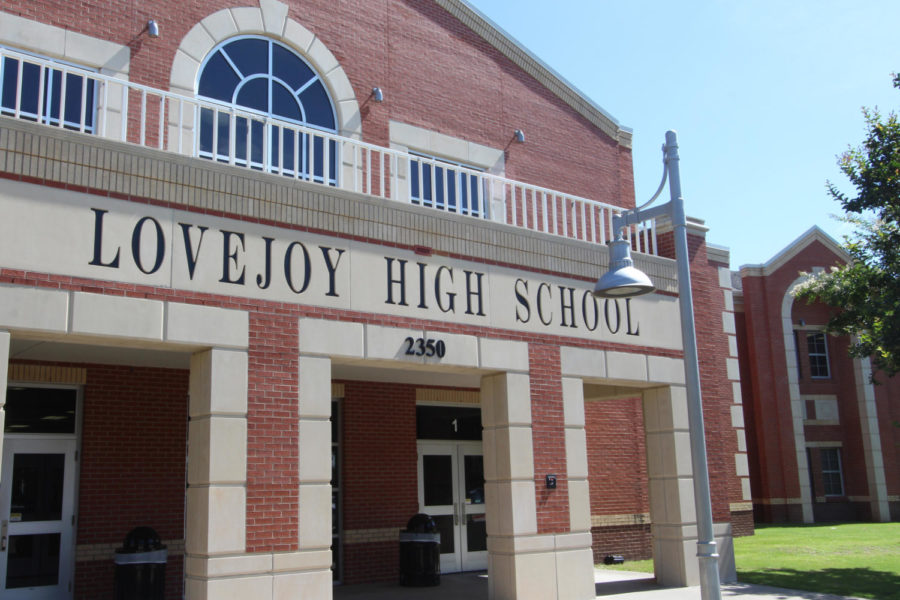Getting the facts on district budget changes
Interim Superintendent Dennis Womack answers TRL’s questions about school finance
Because of state funding cuts to the district, 30 positions have been impacted as a reduction in force.
May 30, 2019
Editor’s note: This interview was conducted via email a few days prior to the Texas House and Senate passing bills on school finance and property tax reform last week. Full details of those bills are still pending and the comments below do not reflect that information.
After years of decreased funding, the district has found itself with even more decreased revenue from the state. With the school expected to lose $5 million in the upcoming school year, the district continues to make efforts to keep heads above water and stress out of the classroom. TRL’s Ariel Kokoricha interviewed Interim Superintendent Dennis Womack to get the facts on the cuts.
The Red Ledger: What is the economic history of Lovejoy over the past few years that has brought us to this point?
Dennis Womack: The State of Texas has cut the Lovejoy budget over the last eight years amounting to $7 million dollars per year of less funding. Following the reduction of property tax rates by 1/3 in 2006, the Legislature promised to keep districts whole by providing ASATR (Additional State Aid for Tax Reduction) funding to maintain at least the same level of per-student funding for weighted average daily attendance. In 2011, the Legislature chose to significantly reduce funding for public education, including ASATR, with the promise to return those funds in 2013. In 2011, the State cut Lovejoy $3 million dollars, but only returned $600,000 in 2013. In 2015, the State cut Lovejoy another $2.1 million per year which was offset by the Lovejoy community passing an 11 cent tax increase (TRE). Then the State of Texas revoked ASATR in 2017, but Lovejoy was instrumental in working with the Legislature to create a two-year Hardship Grant/Aid for the over 200 school districts unduly harmed by the loss of ASATR. Unfortunately, even with the Hardship Grants, Lovejoy was still cut another $2 million dollars per year. Finally, with the loss of the Hardship Grants and a projected increase in recapture from the State, for the 2019-2020 school year, Lovejoy is expected to lose $4.9 million more per year.
TRL: How is the district affected by the Robin Hood plan?
DW: Lovejoy is still a Robin Hood district and we are required to send money back to the state. This school year, we will pay the state $1 million in recapture payments and without a change in law, we estimate our recapture payment will increase to over $2 million.
TRL: Is it true that the middle school will change to a seven period day next year?
DW: Yes.
TRL: What are the first methods that the district uses to combat budget issues?
DW: In the prior years, Lovejoy has taken bold steps to offset the loss of state funding with new sources of revenue, cutting far away from the classroom, cutting as many non-personnel items as possible, and initiating other significant austerity measures. The district has worked strategically to develop innovative sources of revenue. These revenue producing programs are currently contributing over $2 million dollars to our revenue stream outside of state funding: transfers with tuition, tuition based Pre-K program, summer enrichment offerings, campus camp outs at our elementary schools, SAT prep courses and increased football season ticket prices.
TRL: What will the last resorts be?
DW: During this legislative session, it has become increasingly clear that Lovejoy is being forced to take more painful steps, in addition to those that we have already implemented in the past, in order to balance our budget. As a last resort, all programs will be considered except for anything legally required by the state to be provided.
TRL: Are there any ideas the district or school board is attempting to work through to amend or lessen the burden of the situation?
DW: In addition to the items listed above, other options might be: charge students a “pay to play” fee for extra and co-curricular activities (athletics and fine arts); reduce or charge a fee for bus service for students to and from school; reduce Gifted & Talented services; reduce Special Education services; charge a districtwide safety and security fee to cover the cost of the security officers; charge a program enhancement fee for K-6 students; deplete the district’s fund balance used for cash flow to make monthly payroll and to cover unknown or unexpected expenditures.
TRL: What do you see as the best outcome for Lovejoy financially?
DW: Maintaining the programs, activities, and systems in place that makes Lovejoy, “Lovejoy.” To do this, we need for the state to full fund all school districts, including Lovejoy. And for the state to develop a reasonable, sustainable, and responsible state funding system for public education.
TRL: What do you see as the worst-case scenario for Lovejoy financially?
DW: Worst-case scenario would be for the state to continue to under-fund public education and continue to take property taxes levied by local school districts for public education and spending those dollars on other state services. If the state continues this practice, and Lovejoy continues to receive less state funding every year, eventually, the programs, activities, and systems we have in place that define the Lovejoy student experience will no longer exist.
TRL: Are there any rumors or common misconceptions you would like to dispel about the way Lovejoy uses its money or the depth of the issues we’re having?
DW: There is a misconception that Lovejoy can afford to invest in a scoreboard, buses, and technology equipment instead of teacher salaries. There are two separate budgets we manage, as do all school districts. A capital expense budget (I&S – Interest and Sinking) and a general fund budget (M&O – Maintenance & Operations). Each of these budgets are supported separately with their own tax rate and tax collections. Tax dollars collected for the capital expense budget may only be used to fund capital expenses and may not be used for paying salaries, utilities, copy paper, instructional supplies, etc. The dollars invested on a scoreboard, buses or technology equipment could not legally be spent on teacher salaries or program costs.
TRL: How is each specific campus cutting back?
DW: Because over 80% of the district’s budget is in personnel, unfortunately, staffing is the only area left to be cut. These staff reductions will cause some reorganization, which means there will be some re-tooled positions as we restructure for a more cost-effective, leaner model in the impacted areas. Our primary focus, as we face this very difficult challenge, remains to provide quality academic instruction with more limited resources. Make no mistake, staff reductions will have an effect on the Lovejoy ISD. But as we restructure, the district will strive to make the most effective use of our more-limited resources, and we will continue our efforts to improve student achievement.
TRL: Can the district afford to hire any more staff members?
DW: Only where it is legally required or enrollment necessitates. For example, Texas school districts are required to keep elementary classes with no more than 22 students per class. If we have a grade level at elementary that has 98 students, four sections would not be enough to meet the legal requirement; therefore, we would have to add a teacher at that grade level.
TRL: Is the district still hiring?
DW: Only where legally required or to replace a vacant position that was not part of the reduction in force.
TRL: How many staff members are being “let go?”
DW: The official terminology is a “reduction in force (RIF) due to a program change requiring the nonrenewal of a term contract.” There are 30 positions impacted by the RIF. The staff impacted by this RIF will be given every opportunity to reapply for other open positions in the district.
TRL: Is the goal to reduce the number of teachers or the number of paid hours?
DW: The goal of a reduction in force is to reduce payroll expenditures in the most prudent fiscally efficient way, yet in a respectful and dignified manner. Regrettably in most cases, this requires reducing the number of teachers.





